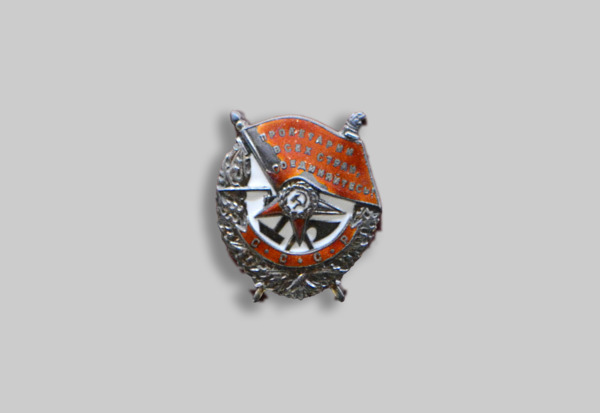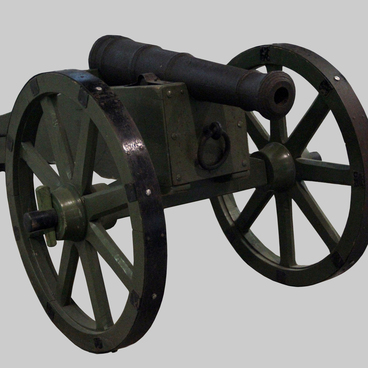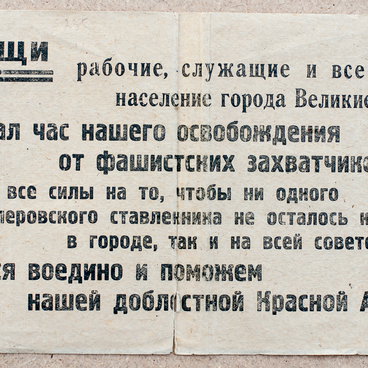The order presented in the museum’s exposition belonged to the announcer and translator of the sound broadcasting station at the political department of the 3rd Shock Army, senior lieutenant MikhaIl ShIshkin.
He served in the active army from the first months of World War Two and showed courage and determination in combat.
Shishkin conducted propaganda programs on the front line, 300–400 meters from the enemy, under machine-gun fire. From August 30 to December 13, 1942, before arriving in the VelIkiye LUki district, Shishkin was behind enemy lines with a band of partisans.
The Order of the Red Banner is one of the highest orders of the USSR. It was established by Decree of the Presidium of the Central Executive Committee of the Soviet Union dated August 1, 1924. The Order was awarded for especially significant feats: courage shown in combat with obvious danger to life, leadership in especially difficult military operations, dedication in defending the Fatherland, and other.
The history of awarding Mikhail Shishkin the Order of the Red Banner is connected with the events that took place during the Velikiye Luki offensive operation. During this operation, the troops of the 3rd Shock Army under the command of Major General Kuzma Galitsky recaptured the city of Velikiye Luki from the Nazis.
The main blow to the enemy was inflicted by the soldiers of the 257th and 357th rifle divisions, and the auxiliary one by the units of the 8th Estonian National Corps. In the offensive, the 3rd Shock Army was supported from the air by the pilots of the 1st assault air corps of the 3rd Air Army.
According to the plan of the Soviet command, it was decided to take Velikiye Luki by storm. It began on December 13, 1942. After two hours of artillery preparation, the assault detachments launched an attack.
Shishkin conducted propaganda programs on the front line, 300–400 meters from the enemy, under machine-gun fire. From August 30 to December 13, 1942, before arriving in the VelIkiye LUki district, Shishkin was behind enemy lines with a band of partisans.
The Order of the Red Banner is one of the highest orders of the USSR. It was established by Decree of the Presidium of the Central Executive Committee of the Soviet Union dated August 1, 1924. The Order was awarded for especially significant feats: courage shown in combat with obvious danger to life, leadership in especially difficult military operations, dedication in defending the Fatherland, and other.
The history of awarding Mikhail Shishkin the Order of the Red Banner is connected with the events that took place during the Velikiye Luki offensive operation. During this operation, the troops of the 3rd Shock Army under the command of Major General Kuzma Galitsky recaptured the city of Velikiye Luki from the Nazis.
The main blow to the enemy was inflicted by the soldiers of the 257th and 357th rifle divisions, and the auxiliary one by the units of the 8th Estonian National Corps. In the offensive, the 3rd Shock Army was supported from the air by the pilots of the 1st assault air corps of the 3rd Air Army.
According to the plan of the Soviet command, it was decided to take Velikiye Luki by storm. It began on December 13, 1942. After two hours of artillery preparation, the assault detachments launched an attack.
Heavy street fighting ensued, the Nazis put up serious resistance.
Two days after the beginning of the assault, the Soviet command sent envoys to the headquarters of the encircled Nazi garrison. This is the first time in the history of the Eastern Front of World War Two when it was decided to negotiate to stop the bloodshed. The envoys were Senior Lieutenant Mikhail Shishkin and Lieutenant IvAn SmirnOv.
On December 15, they gave the representatives of the German headquarters an ultimatum to surrender. But the Nazis rejected the terms of surrender, and the fierce street battles that did not subside either day or night continued. Despite this, the first Soviet envoys were awarded the Order of the Wartime Red Banner for exemplary performance of the assignment.
Two days after the beginning of the assault, the Soviet command sent envoys to the headquarters of the encircled Nazi garrison. This is the first time in the history of the Eastern Front of World War Two when it was decided to negotiate to stop the bloodshed. The envoys were Senior Lieutenant Mikhail Shishkin and Lieutenant IvAn SmirnOv.
On December 15, they gave the representatives of the German headquarters an ultimatum to surrender. But the Nazis rejected the terms of surrender, and the fierce street battles that did not subside either day or night continued. Despite this, the first Soviet envoys were awarded the Order of the Wartime Red Banner for exemplary performance of the assignment.



